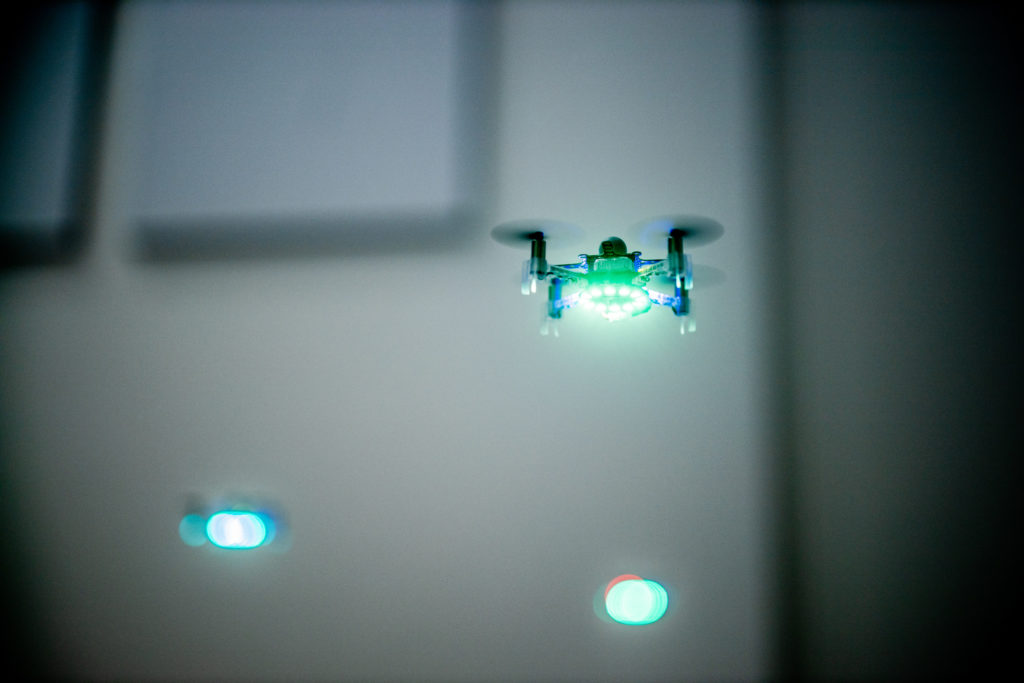Scientists of the doctoral school “Networked Autonomous Aerial Vehicles” implemented a self-adaptive swarm of drones and showcased it in Klagenfurt’s new drone hall, one of the largest and most modern facilities of its kind.
Written by Christian Bettstetter and Petra Mazdin. Photo by Michał Barciś.
The night sky over the Austrian city of Linz was spectacularly illuminated one evening in September 2012, when the Ars Electronica Futurelab launched almost fifty light-equipped quadcopters to fly in formation. Probably for the first time in history, they realized what is nowadays called a drone display and has become a novel form of art and entertainment. To highlight major events, such as the Olympic Games and the Super Bowl, professional light shows comprising several hundred drones are staged. Companies like Intel and Ehang offer them at prices above $100,000.
The way how to coordinate drones in space and time is a key technical task in these shows. It is handled by path planning algorithms, which compute the locations required for each drone during the entire performance. Most drone shows are precomputed, which means all entities follow given paths that cannot change during the flight. Such offline planning is sufficient under static conditions but is inappropriate for applications in which drones must navigate in unknown or changing environments. Even wind is problematic when using precomputed flight paths and may lead to uncoordinated movements. These dynamic scenarios call for a different approach in which drones are not preprogrammed but compute their flight paths in real-time in order to adapt to changes in the environment and within the system itself.
Such a self-adaptive system has now been realized by the Karl Popper science Kolleg “Networked Autonomous Aerial Vehicles” at the University of Klagenfurt, namely by four doctoral students along with their professors. The hands-on work is grounded on a mathematical model that combines synchronization and swarming into one common theory, recently proposed in the article “Oscillators that sync and swarm” by Kevin O’Keeffe, Hyunsuk Hong, and Steven Strogatz. The entities defined in this model, called swarmalators, are able to form five different types of space-time patterns. These patterns are not known in advance but emerge over time in a self-organizing manner. A unique feature of the model is the bidirectional interaction between synchronization and swarming. For example, neighboring entities may tend to synchronize, or entities in synchrony may attract each other. We have implemented the swarmalator model in tiny quadcopters, called Crazyflies, weighing only 27 grams and measuring nine square centimeters. A team of Crazyflies is managed using the Crazyswarm platform.
“Compared to commercial aerial entertainment shows, our performance is not pre-programmed — drones decide on the fly where to go, so each demonstration is unique,” doctoral student Agata Barciś emphasizes. Some months ago, she extended the swarmalator theory to work with the specific movement characteristics of robots and implemented it in the Robot Operating System 2 (ROS2). Our team in Klagenfurt was actually the first to demonstrate the feasibility of robotic swarmalators using small, self-balancing ground robots. This proof-of-concept was already exciting on the ground, but swarmalators in the air are even more visually appealing and offer opportunities for three-dimensional patterns to be realized in future work.
Our drones that sync and swarm were presented in the new drone hall of the University of Klagenfurt, located adjacent to the university campus in the Lakeside Science and Technology Park. “We now have one of the largest and most modern indoor research space for aerial vehicles with arguably the biggest tracking volume throughout Europe,” professor Stephan Weiss, speaker of the doctoral school and drone enthusiast, proudly announces. In fact, the hall is ten meters high with a floor area of 100 square meters (extensible to 150 square meters by opening a large sliding door). The technical infrastructure comprises 5G connectivity, dimmable lighting, and, most important, submillimeter-precise position tracking realized by 37 OptiTrack motion capture cameras operating at a rate of up to 360 Hz. A protected control and visitor center ensures workplace safety.
All faculty members — Christian Bettstetter, Hermann Hellwagner, Bernhard Rinner, Stephan Weiss — and doctoral students — Agata Barciś, Michał Barciś, Roland Jung, Petra Mazdin — are looking forward to the official opening of the drone hall next week. About 150 invited guests will be present to see our glowing drones moving in synchrony and forming dynamic color patterns in the air.
Photos

Popper Kolleg and dean at the drone hall opening on Dec 10, 2019. Photo by J. Röttl for U Klagenfurt.

A swarm of Crazyflie drones. Photo by D. Waschnig for U Klagenfurt.

